PHILOSOPHY
Paper – II
Note : This paper contains fifty (50) objective type questions of two (2) marks each. All questions are compulsory.
1. In vedic tradition the movement of earth was regulated by
(1) Brahman
(2) Iśvara
(3) Rta
(4) Sūrya
2. Which type of rna in Vedic tradition can be repaid by performing Yajña ?
(1) Rsirna
(2) Devarna
(3) Pitrrn
(4) Prthvirna
3. The term ‘Paryāya’ in Jaina thought refers to
(1) Āgantuka Dharma
(2) Nitya Dharma
(3) Manah Paryāya
(4) Naya
4. Given below are an Assertion (A) and a Reason (R). Consider them and select the correct code given below in the context of Cārvāka Philosophy.
Assertion (A) : The dead body must be conscious.
Reason (R) : Consciousness is an attribute of body.
Codes :
(1) (A) and (R) both are true and (R) is the correct explanation of (A).
(2) (A) and (R) both are true and (R) is not the correct explanation of (A).
(3) (A) is true and (R) is false.
(4) (A) is false and (R) is true.
5. Who among the following holds that blue colour and the knowledge of the blue colour are one and the same ?
(1) Bhaspati
(2) Vasubandhu
(3) Bhāsarvañjna
(4) Prabhākara
6. Consider Set – I and Set – II and select the code correctly matched given below :


7. According to the Naiyāyikas Samavāya is perceived by the Sannikarsa known as
(1) Samavāya
(2) Samaveta samavāya
(3) Sayukta samavāya
(4) Viśesanatā
8. In Nyāya Philosophy of language Īśvarecchā is :
(1) The cause of sákti
(2) The cause of Laksanā
(3) Śakti itself
(4) The cause of Śābdabodha
9. Which system takes the help of adrsta to prove the existence of god ?
(1) Nyāya only
(2) Nyāya and Vaiśe ika
(3) Nyāya, Vaiśe ika and Yoga
(4) Yoga and Vaiśe ika
10. Select the code that states the correct sequence :
(1) ksipta, mūdha, viksipta, ekāgra, niruddha
(2) mūdha , ksipta, viksipta, ekāgra, niruddha
(3) ksipta, viksipta, mūdha, ekāgra, niruddha
(4) niruddha, ekāgra, Mūdha, ksipta, viksipt
11. Match List – I with List – II and choose the correct answer with the help of codes given below :

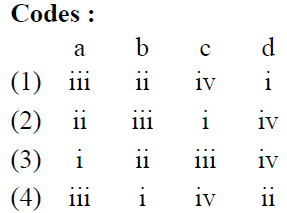
12. Match List – I with List – II and choose the correct answer with the help of codes given below :


13. Given below are an Assertion (A) and a Reason (R). Consider them and select the correct code given below in the context of Śa kara’s Philosophy.
Assertion (A) : Brahman is abhinna nimitto pādāna Kārana of jagat.
Reason (R) : There is nothing other than Brahman.
Codes :
(1) Both (A) and (R) are true and (R) is the correct explanation of (A).
(2) Both (A) and (R) are true and (R) is not the correct explanation of (A).
(3) (A) is false and (R) is true.
(4) Both (A) and (R) are false.
14. Select the correct sequence of the gradations of Moksa in Madhva Vedānta
(1) Sāyujya, Sārūpya, Sāmpya, Sālokya
(2) Sālokya, Sāmpya, Sārūpya, Sāyujya
(3) Sārūpya, Sāmpya, Sālokya, Sāyujya,
(4) Sālokya, Sāyujya, Sārūpya, Sāmpya,
15. In the view of Śa kara, the only pramāna that imparts knowledge of Brahman is
(1) Arthāpatti
(2) Pratyaksa
(3) Anumāna
(4) Śabda
16. The Indian philosopher who makes a distinction between Anupramāna and Kevala pramāna is
(1) Patañjali
(2) Śankara
(3) Madhva
(4) Īśwaraksna
17. One of the steps in Sādhana Catustaya according to Śankara is
(1) Prakrti- purusa jñāna
(2) Mumuksuttva
(3) Nityavibhūti jñāna
(4) Anumāna jñāna
18. The teaching common to all the vedāntins is that Brahman is
(1) Nirguna
(2) Saguna
(3) Saguna – nirguna
(4) Ananta
19. Given below are some modes of subjectivity :
i. Bodily Subjectivity
ii. Psychic Subjectivity
iii. Spiritual Subjectivity
iv. Religious Subjectivity
Which three modes of Subjectivity are accepted by K.C. Bhattacharya ? Select the correct answer from the codes given below :
Codes :
(1) i iii iv
(2) ii iii iv
(3) i ii iii
(4) i ii iv
20. Which one of the following holds the view that ‘when you deprive truth of its appearance, it loses the best part of reality’ ?
(1) Sri Aurobindo
(2) Tagore
(3) J. Krishnamurti
(4) Vivekananda
21. Who among the following holds the view that ‘space, time and causation are not metaphysical realities, they are mere forms’ ?
(1) Tagore
(2) Vivekananda
(3) Radha Krishnan
(4) J. Krishnamurti
22. Who among the following holds the view that ‘creation is plunge of the spirit into ignorance’ ?
(1) Tagore
(2) Gandhi
(3) Vive Kanandan
(4) Sri Aurobindo
23. Match List – I with List – II and select the correct answer from the code given below :


24. Match List – I with List – II and choose the correct answer with the help of codes given below :
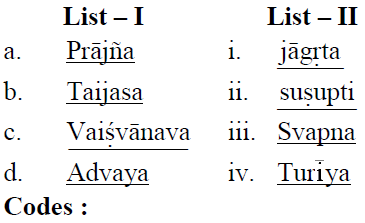

25. Match List – I with List – II and choose the correct answer with the help of codes given below :
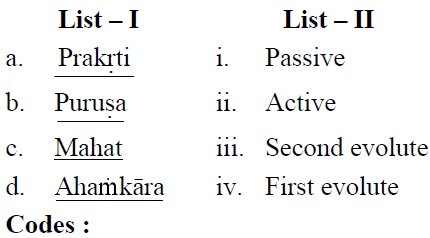
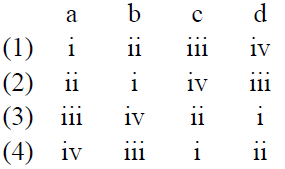
26. In the context of Locke’s philosophy, consider the given Assertion (A) and Reason (R) and then mark the correct option as given below :
Assertion (A) : All our knowledge is A posteriori.
Reason (R) : Knowledge is received through sensation and reflection.
Options :
(1) Both (A) and (R) are true and (R) does not provide the correct explanation of (A).
(2) (A) is true and (R) is false but (R) does not provide the correct explanation of (A).
(3) (A) is true and (R) is false but (R) provides the correct explanation of (A).
(4) Both (A) and (R) are true and (R) provides the correct explanation of (A).
27. Match List – I with List – II and mark the correct code :


28. Sensationism, Empiricism and Representationism are altogether attributed to
(1) Hume
(2) Locke
(3) Kant
(4) Berkeley
29. Match List – I with List – II and mark the correct code from given below :
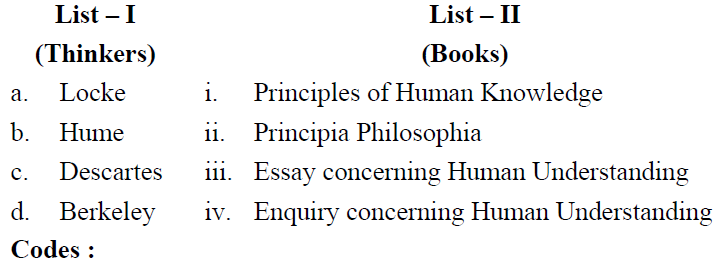

30. The distinction between impression and idea was made by
(1) Kant
(2) Locke
(3) Hume
(4) Berkeley
31. Given below are two statements, one labelled as Assertion (A) and the other labelled as Reason (R). Considering (A) and (R) in the light of logical positivism select the correct code :
Assertion (A) : According to the principle of verification ‘meaning of a proposition isthe mode of its verification’.
Reason (R) : All the statements which could neither be verified nor falsified by experience are meaningful.
Codes :
(1) Both (A) and (R) are true and (R) is the correct explanation of (A).
(2) Both (A) and (R) are true and (R) is not the correct explanation of (A).
(3) (A) is true, but (R) is false.
(4) (A) is false, but (R) is true.
32. Which one of the following statements is true with reference to St. Thomas Aquinas ?
(1) God’s essence is identified with Reason.
(2) God’s essence is identified with his existence, as pure actuality.
(3) God’s essence is identified with his potentiality.
(4) God has only existence, but no essence.
33. As per Aristotle’s distinction between various sciences, “the pure and abstract knowledge” is dealt by
(1) Theoretical sciences such as Politics and Ethics
(2) Practical sciences such as Theology and Metaphysics.
(3) Theoretical sciences such as Mathematics and Physics.
(4) Practical Sciences such as politics and Ethics
34. Given below are two statements, one labelled as Assertion (A) and the other labelled as Reason (R). Considering (A) and (R), mark the correct code.
Assertion (A) : Plato rejected the view that “knowledge is opinion” in his theatetus.
Reason (R) : Knowledge must be grounded on faith, and not on Reason.
Codes :
(1) Both (A) and (R) are true and (R) is the correct explanation of (A).
(2) Both (A) and (R) are true and (R) is not the correct explanation of (A).
(3) (A) is true, but (R) is false.
(4) (A) is false, but (R) is true.
36. Who among the following believed that “All things are full of Souls and Spirits”?
(1) Democritus
(2) Heraclitus
(3) Parmenides
(4) Pythagoras
37. Which of the following statements are true with reference to Protagoras. Mark the correct code :
(i) Man is the measure of all things.(ii) Truth is objective.
(iii) What is true to one person need not be so to the other.
Codes :
(1) only (i) is true.
(2) only (i) and (ii) are true.
(3) only (i) and (iii) are true.
(4) only (ii) and (iii) are true.
38. Gilbert Ryle’s theory of “Ghost in the Machine” rejects
(1) Descarte’s Body-Mind Dualism
(2) Berkeley’s Idealism
(3) Spinoza’s Pantheism
(4) Rational capacity of the mind as such
39. Match the List – I with List – II and select the correct answer by using the codes below :


40. According to Hegel, the absolute mind expresses its essence of truth in the form of Intuition in
(1) Morality
(2) Art
(3) Religion
(4) Philosophy
41. ‘Being-towards-death is a constant fleeing in the face of death’ expresses the philosophy of
(1) Russell
(2) Husserl
(3) Heidegger
(4) Moore
42. Match the List – I with List – II and select the correct answer by using the codes below :

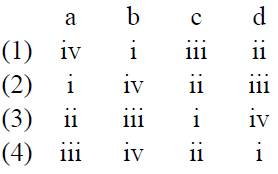
43. Match the List – I with List – II and select the correct answer. For Descartes, the human body is like a machine.


44. The ‘Predicate-in subject’ principle is propounded by
(1) Descartes
(2) Leibnitz
(3) Spinoza
(4) Locke
45. The essence of the ‘new man’ is joyful wisdom according to
(1) Husserl
(2) Moore
(3) Nietzsche
(4) Frege
46. Consider the Assertion (A) and Reason (R) and select the correct code from given below :
Assertion (A) : According to Russell, ‘Denoting phrases never have any meaning in themselves’.
Reason (R) : I In, ‘the brother of Charles II was deposed’, ‘Charles II was deposed is a denoting phrase’, and thus, has no meaning.
II In, ‘the brother of Charles II was deposed’, the brother of Charles II is a denoting phrase and thus, has no meaning.
Codes :
(1) (A) is true and (R) I, II correctly explain (A).
(2) (A) is true and (R) I is correct explanation of (A) and (R) II is false.
(3) (A) is true and (R) II is a correct explanation of (A) and (R) I is false.
(4) (A) is true but neither (R) I nor (R) II correctly explains (A).
47. Consider the Assertion (A) and Reason (R) & select the correct code given below :
Assertion (A) : Monads have no windows.
Reason (R) : I Nothing is passed to them from outside.
II Each of their state is generated from their own nature.
III Monads do not interact.
Codes :
(1) (A) is true and (R) I, II, III are correct explanations of (A).
(2) (A) is true and (R) I is the only correct explanation of (A).
(3) (A) is true and (R) I, II are correct explanations of (A).
(4) (A) is true and (R) II, III are the correct explanations of (A).
48. Consider the following statements in the light of Russell’s logical Atomism and mark the correct code :
(i) Corresponding to individual variables and propositional functions of logic, the world contains particulars and universals.
(ii) Corresponding to the particulars and universals of the logic, the world contains variables and propositional functions.
(iii) The world contains independent atomic facts corresponding to the simple propositions.
Codes :
(1) only (i) is true.
(2) only (i) and (ii) are true.
(3) only (i) and (iii) are true
(4) only (ii) and (iii) are true.
49. Consider the following statements in the light of pragmatism and mark the correct code :
(i) Both William James and C.S. Peirce agree completely on the method of pragmatism.
(ii) William James went beyond Peirce in presenting a moral theory on pragmatic grounds.
(iii) C.S. Peirce called his own theory as pragmaticism.
Codes :
(1) only (i) is true.
(2) only (i) and (ii) are true.
(3) only (ii) and (iii) are true.
(4) only (i) and (iii) are true.
50. Who among the following philosophers advocated “Pragmaticism” ?
(1) William James
(2) C.S. Peirce
(3) G. Ryle
(4) A.J. Ayer
Latest Govt Job & Exam Updates: